by Wellington C. Ramos, Adjunct Professor of History and Political Science
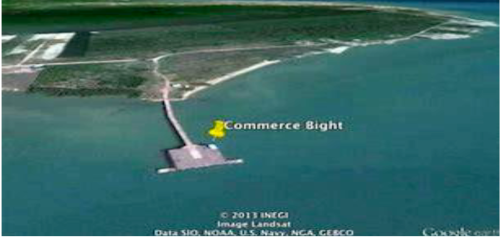
Commerce Bight Pier in Dangriga Town, built in 1908
Tues. Apr. 11, 2023
In 2002, the PUP Prime Minister of Belize, Said Musa, and his administration gave the Commerce Bight Port to a friend of his, Luke Espat, without consulting and getting the approval of the Garifuna citizens of Dangriga, free of cost. After he took possession of the port, he constructed a fence and a gate, employed a watchman, and deprived the Garifuna citizens of entry into and use of the facility. Since then, the Garifuna people are still being prohibited from using the port or any area in the vicinity.
This is a picture of the fence and gate that were erected by Luke Espat and his company, Belize Ports Limited, in 2002.
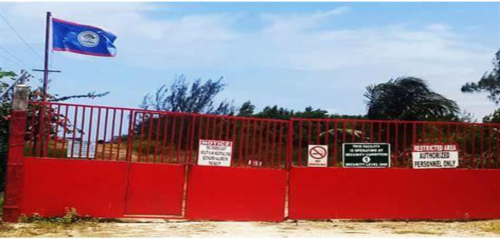
The UDP came to power in 2008 and promised the Garifuna citizens of Dangriga that they would take back the port from Luke Espat and hand it over to the people of Dangriga. In 2013, the UDP government took Luke Espat to court to repossess the port. Luke Espat and his company had taken out a loan from Belize Bank and defaulted on his payments.
Michael Ashcroft, who owns Belize Bank, took Luke Espat to court and won his case. He asked the Belize government for all the ports under Luke Espat’s control to be granted to him; but the Barrow administration worked out an agreement with him, whereby all the ports except Commerce Bight Port were to be contracted to him. All this time, the Commerce Bight Port remained dormant.
The PUP won the General Elections in 2020, and a company by the name of Recological Services Limited (RSL) presented a contract to them that was signed by the UDP government with a twenty-five (25)-year lease. This is without consulting the Garifuna people and their organizations, who own this indigenous land located in the Garifuna Reserve-2 in Dangriga Town where the Commerce Bight Port is located.
The PUP decided not to honor the contract because they said it was not legitimate. The company threatened to sue the PUP administration. The PUP government responded by bringing the issue to the National Assembly to have the contract voided. They were acting as if the land and the port belong to them.
To the Garifuna Nation’s and their citizens’ surprise, about two weeks ago the PUP Prime Minister of Belize, Hon. John Briceño, announced that his government is planning to reopen the Commerce Bight Port. He continued by saying that he has assembled a group of his Ministers to work on a plan. The elected area representative of Dangriga, Hon. Dr. Louis Zabaneh, the representative for Stann Creek West, Hon. Rodwell Ferguson, and no Garifuna individual or organizations were contacted or included as a part of this planning team.
THIS IS THE PICTURE OF A SHIP DOCKING AT COMMERCE BIGHT PORT.
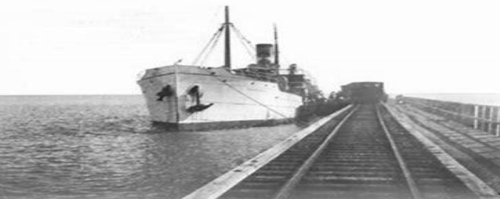
Again, the Garifuna Nation and their citizens in Dangriga and Stann Creek District were never consulted by the Prime Minister and his government to seek our Free, Prior and Informed Consent (FPIC), as is required under international Law, to use our indigenous lands. This is a repeat of what the PUP Prime Minister, Said Musa, did in 2002 when he granted our port to Luke Espat, and the UDP Prime Minister, Dean Barrow did when he granted a contract to RSL in 2018. It is clear that these two political parties have no regard for indigenous peoples’ land and human rights as is listed below in the UNDRIP document.
The collective rights of indigenous peoples to lands, territories and resources are firmly embedded in the United Nations Declaration on the Rights of Indigenous Peoples (Articles 3 and 26) as well as in the International Labour Organization’s Indigenous and Tribal Peoples Convention No. 169 and its predecessor Convention No. 107.
Balliceaux, an island off the coast of St. Vincent, where many Garifuna people were unlawfully imprisoned, tortured, killed and buried.
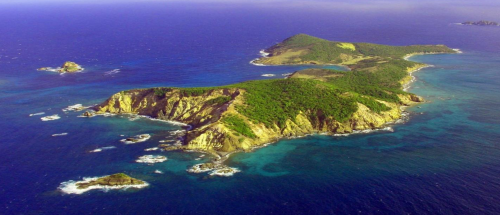
In 1796, after the British captured our nation, they imprisoned about 5,000 of our people: men, women and children, on the desolate island of Balliceaux off the coast of the St. Vincent mainland. On that island they continued their torturing and killing of our people, which resulted in about half of the total amount dying and being buried on the island where their remains are left up to this day. It is said that only about 2,500 of our people survived that genocidal act.
The British king at the time, George III (1760-1801), then gave orders for our people who survived to be removed from Balliceaux to their distant colonized Bay Island, Roatan, Honduras, on eleven ships. Upon our people’s arrival on the island, their names were changed from their original names to Spanish names to conceal their identities and also to make it difficult for us to reconnect with our families in our motherland, St. Vincent and the Grenadines. Our ancestors did not like the living conditions on the island of Roatan in Honduras, and appealed to the British to allow them to leave to a better place.
The British granted their request and allowed about 165 of them to sail to British Honduras, now known as Belize, where they landed on November the 19th 1802. They landed on the south side of Belize City, in an area now known as ‘Yabra’. The British at the time had some people from the continent of Africa as slaves, known today as ‘Creoles’. The British did not want the Garifuna people to intermingle with the Creoles, for fear that they were going to encourage them to revolt against the British for their freedom. Also, the British knew that the Garifuna people had a history of taking away slaves from the European slave masters to make them free people.
This was what the British experienced when they had controlled their nation, St. Vincent, and they (the British) did not want them (the Garifuna people) to do the same thing in Belize. The Spanish in Honduras also began to allow more of our Garifuna people to move to the mainland along the coast because they wanted us to fight with them against the British for disputed territories. Later on, the Nationalistas, who were demanding their independence from Spain, forged an alliance with the Garifuna people.
Roatan, Honduras, part of the Bay Islands where the Garifuna people were dumped by the British on April 12, 1797.
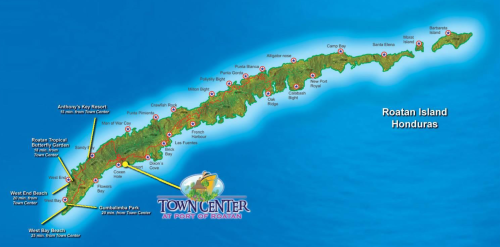
British and Spanish rivalry over the Americas was constant, and they were both competing to control the entire region. When the British and the Spanish granted us permission to stay in the areas where we lived, there were some restrictions not to move away from the south of Belize, but to stay confined in that region. They did not want the Creole people, who they had as slaves, to know that there were free black people living in Belize. It seems as if the Creoles found out afterwards, and questioned them about our free status.
British and Spanish rivalry over the Americas was constant, and they were both competing to control the entire region. When the British and the Spanish granted us permission to stay in the areas where we lived, there were some restrictions not to move away from the south of Belize, but to stay confined in that region. They did not want the Creole people, who they had as slaves, to know that there were free black people living in Belize. It seems as if the Creoles found out afterwards, and questioned them about our free status.
They then started to tell them that we, the Garifuna people, were cannibals and that we ate people, and all other sorts of lies to justify their actions against both of us. The southern part of Belize was not for Britain, so they did not have the right to grant us permission to stay there. In the Treaty of Paris signed with Spain in 1763, the British were granted permission only to cut logwood and mahogany up to the Sibun River on Spain’s territory. Spain acquired this territory when they signed the Treaty of Tordesillas with Portugal in 1494. Britain and Guatemala signed the 1859 Treaty, which gave Britain the rights to the land from the Sibun River to the Sarstoon and to the west, known as Cayo District today.
If there was a war between the British and the Spanish over that region at the time, we, the Garifuna people, were going to suffer the consequences of the war. We were left by the British to find ways and means to survive on our own without any assistance from them. In the southern part of Belize we found the ways and means to survive as villages on our own by engaging in farming to plant our food items, and by fishing and hunting for our meat.
Between 1802 and 1837, the villages of Stann Creek, Hopkins, Punta Gorda, Seine Bight and Barranco were all experiencing growth in their populations and were self-sustaining communities. When slavery was abolished in Belize in 1833, the Creoles became free people but had to go through the Emancipation era to get educated and learn trades to be able to take care of themselves. We began to intermingle among ourselves but, because of the brainwashing that the British did to some of our fellow Creole brothers and sisters, the relationship was strained, and is still difficult to heal up to this day.
The Garifuna and the Creole people must come together as people of African descent to survive in Belize. They are now a minority group in the country of Belize, due to a continued Mestizo migration from the neighboring countries. Before Belize became a Crown colony in 1862, the British sent an Evaluator from the British Commonwealth Office to tour the entire country of Belize and to provide them with an economic, social, cultural and political report. His findings revealed that the Garifuna people were the only people in Belize that were self-sufficient.
From 1832 until 1954, when our country received Adult Suffrage, we were taking care of our villages and ourselves without much assistance from the British or Spanish Crowns in Honduras, Nicaragua, Guatemala and Belize. We also communicated back and forth with all of our relatives in these countries.
When the People’s United Party (PUP) became the first political party to form a local Legislative Assembly in 1954, like most other Belizean people, we joined their party. This was with the hope that they would assist us socially, economically and politically. Most of the families I knew that were related to me growing up in Dangriga were PUPs.
This is while all of the members of our families went to their farms, worked in Pomona, Alta Vista, Middlesex, Cave Branch, Commerce Bight Pier, and did other types of work to support their families and themselves. Some Garifuna people even left the country to Honduras, Panama and the United States to seek employment. The PUP had little impact on improving the social, economic and political life of our Garinagu people in the south.
If they wanted to help the Garifuna people, they could have given us the opportunity to become huge farm owners for the citrus, banana, cassava and other crops that we grew, because all Garifuna families in the south owned farms and homes for their families.
The part in red on this map is where the Garifuna people were restricted to, by the British, when they came to Belize in 1802. Guatemala is now claiming this same area of land from Belize.
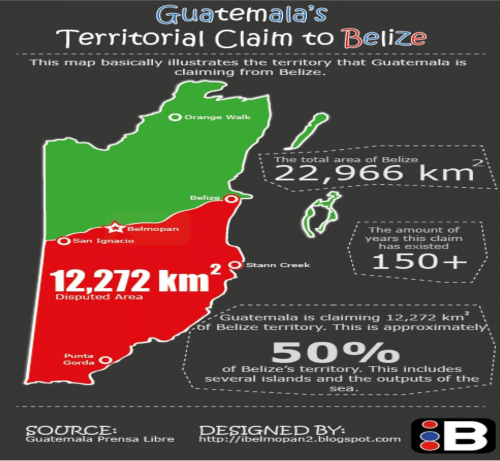
The farmers in the north were, and are still the wealthiest farmers in the country of Belize for a long period of time. When the banana industry was reintroduced in the south in the 1960’s, we were still planting banana, plantain, cassava and many other food crops for decades. Yet, we were never given the opportunity to become huge farmers. The PUP had another opportunity to give our Garifuna people the option again, but refused to do it. Our people kept remaining in their party with false promises, hopes and dreams. The PUP governed Belize from 1954 up until 1984 with little significant improvements in the lives of our Garifuna people.
AN ARIEL VIEW OF COMMERCE BIGHT PORT IN DANGRIGA TOWN
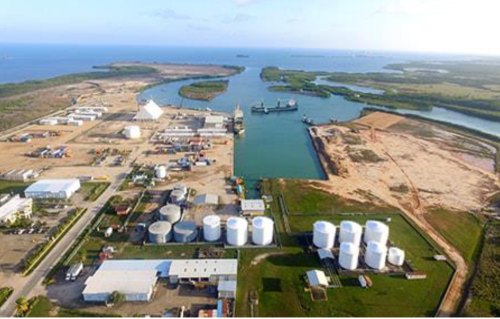
Hurricane Hattie struck Belize in 1961, and after this terrible experience, many Belizeans started to migrate to the United States. This migration affected all the households in Belize, and especially the Garifuna and Creole families. The family members of the Garifuna and Creoles then started to assist their families back home to reduce the burden on the Belize governments.
The UDP came to power for the first time in 1984, and they promised change from the status quo of the PUP. But since they came to power and in all of their administrations, they have failed to bring employment to the south, and to give the Garifuna people the opportunity to own their own businesses to remain independent people, and to have control over their indigenous lands. This has led to an increased state of dependency and poverty.
Many Garifuna families in the south own lands, but the Belize Land Tenure System (BLTS) is being used by the UDP and PUP governments of Belize (GOB) to use, grant leases, and issue titles to Garifuna lands. The Government wants the Garifuna people to apply for a lease and title to lands they already own and have been occupying for centuries.
Obtaining any land document from the Government of Belize takes years, and in many cases will not be granted unless a Garifuna or other citizens pays a member of the government to obtain their land title. A case in point is that I had a Minister’s Fiat Title that I obtained in the early 1990’s for my purchased lot. The Government of Belize discontinued Minister’s Fiats after 2008 and told all the citizens of Belize to apply for a Certificate of Title, and I applied.
I did not receive my Certificate of Title until 2020. Most Belizeans have been, and are awaiting their land titles for over five years. This is despite the fact that they have submitted all the required documents requested by the government’s Lands Department. The citizens of Belize cannot do anything without their land titles. Garifuna citizens also need the finance to work their lands, and both the UDP and PUP have failed to provide it to them through the Development Finance Corporation (DFC).
When the General Elections are coming up in Belize, the two main political parties, PUP and UDP, make several unfulfilled promises, pay our people to vote for them, get elected, reelected, and it goes on and on with no end in sight. Still, many of our people and family members remain loyal to these two political parties. The purpose of a political party, when they become the government, is to assist their citizens with the resources they need to take care of their families and themselves. The two of these political parties, the UDP and PUP, have failed miserably with this task.
There are many of our Garifuna people who still hold on to this lingering belief, that things will get better. Some are even blaming their own people for being lazy and worthless as the main cause for their living status. I believe that if we make the finance and equipment available for our people to work on their farmlands, the situation will get better. I am not recommending the old slash and burn farming, because our people tried that for many years and it did not work. I am talking about the government establishing a program to provide the equipment for our people to clear their lands, give them the seeds to grow the crops, and the money to pay the people for their labor.
Too many years have passed by and the UDP/PUP has no established program for our people. They just continue giving them more unfulfilled promises, like this one again to reopen the Commerce Bight Port when election is approaching. When I listened to the Prime Minister’s comments two weeks ago, he used the word “marina” port. That sends me a message that they will not allow ships to dock there any more, and this is a downsize from what it was, and is capable of being used for. They do not want Commerce Bight Port to compete with the Big Creek Port and the Belize Port.
The Garifuna people in Dangriga and Stann Creek District want the Commerce Bight Port to reopen with their consultation, consent and approval so they can benefit from its use. But the Government of Belize has refused to consult us to gain our consent and approval. This action on their part makes me believe that they do not care about us.
I predicted, in an article that I wrote prior to the 2020 General Elections, that we might not have any Garifuna person in the House of Representatives, and that prediction came true. When the PUP did their first electoral representation reforms in 1960, they gave us two representatives each for the Toledo and Stann Creek Districts.
They did subsequent reforms and increased the number of seats in all the other districts except Toledo and Stann Creek. The Stann Creek and Toledo Districts still only have two seats each. Currently, Redistricting is taking place in secrecy, and we are not being told how many seats the Stann Creek and Toledo Districts will gain when they are finished with their recommendations.
In 2020, the citizens of Belize, including our Garifuna people, elected the PUP with the hope for a change by a landslide. As soon as they came into power, they voided the lease for twenty-five (25) years that was granted by the UDP to RCL Limited in 2016 to reopen the Commerce Bight Pier. The Garifuna Nation was skeptical of the plan at the time because their people and organizations were not consulted before the contract was issued to the company.
Commerce Bight Pier is a port and harbor that has natural depth compared to Big Creek and the Belize City Ports. It does not require ongoing dredging like the other two ports. Also, it is a place where vessels can dock to be safe in the event of a storm and during the hurricane season. It is a multipurpose port facility that has all the amenities to be used, including boat and ship building. Yet, the government of Belize has been neglecting it for 21 years now. Why? Is it because it is in the south where the Garifuna people live? The south has always historically been neglected by the Central Government in Belmopan.
Now in 2023, the PUP government is planning to do the same thing the UDP did, without our Free, Prior and Informed Consent (FPIC). This is convincing me that, it does not matter whether it is the UDP or PUP governing our country as it relates to our Indigenous Human and Land Rights. They will continue to do as they please. Let us demonstrate to them how much we care about ourselves by coming together to confront this government on their proposed Commerce Bight Pier plan.
If we do not confront this government, they will continue to use their Land Tenure System (LTS) to violate our human and land rights in Belize. The Commerce Bight Port is only one case, but there are hundreds of cases that our Garifuna citizens can bring forward, where their lands are occupied, leased or titled, without their consent, knowledge and approval. We are being taken for fools, and now is the time for us to let them respect us. We need Garifuna representatives who will stand up for us and to go to Belmopan and demand our rights, and our fair share of our Belizean national resources.

